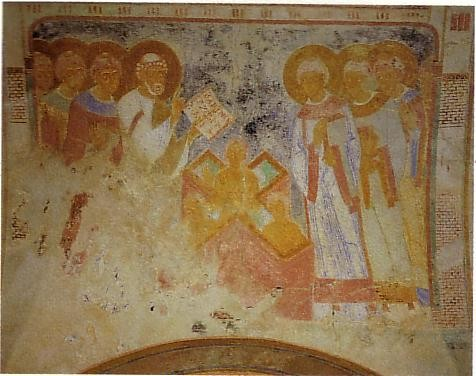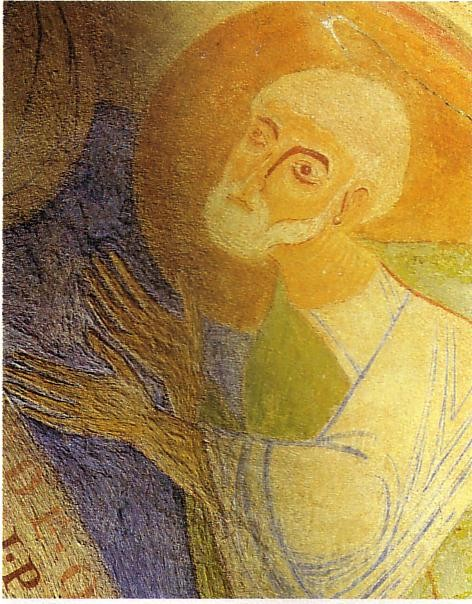Sigwards church in Idensen
a beautiful example of medieval mural painting

The old church in Idensen was built by order of Bishop Sigward of Minden, who died in 1140, as his own, probably for his burial. A well-travelled and experienced builder, he was a close friend of the Emperor Lothar III.
The church was built of carefully shaped sandstone blocks. The simple building has a west tower. The interior is much more elaborate. The nave is divided into three blocks by columns with semi-columns and arches. A highlight is the apse, surrounded by eight slender columns of green stone. The nave opens to the north and south into two side chapels, each with a small niche that once held an altar and a pillar on either side. The upper walls and ceiling of the church have mural paintings of exceptional quality, dating from the original building around 1130. Together with the architecture, they make up a 'work of art' of international standing.
Since the fifteenth century, the original paintings have been covered by several layers of whitewash and remain in this state today. The murals were rediscovered at the end of the 19th century, but were not fully uncovered until 1930-34. Since then, extensive conservation work has been carried out. The church is now air-conditioned to minimise fluctuations in humidity. This serves to stabilise the salt contained in the layers of paint.
Historic murals are valuable cultural and historical artefacts. They give the modern viewer an insight into life in the Middle Ages. In Idensen, Bishop Sigward commissioned a large series of paintings by unknown artists: Scenes from the Old and New Testaments are juxtaposed in the nave, with images of theological content.
T he first pair shows the Baptism and Noah's Ark. They are linked by the common theme of water. In both scenes, water has a destructive and preserving/purifying power. The second pair shows the Tower of Babel opposite the coming of the Holy Spirit at Pentecost. Both images have to do with language: Because man wants to be like God, he confuses his language(s); but because he wants peace on earth, he gives the Holy Spirit, who enables understanding beyond the limits of language. In the third pair, the scene of the Last Judgement is clearly recognisable. On the Old Testament side, this is juxtaposed with the story of Sodom and Gomorrha. The theme here is the separation of the just from the unjust, the righteous from the damned. The three pairs are contrasted with the representation of 'Majestas Domini' (God as Ruler of the World) in the apse, which forms the link between all the images.
he first pair shows the Baptism and Noah's Ark. They are linked by the common theme of water. In both scenes, water has a destructive and preserving/purifying power. The second pair shows the Tower of Babel opposite the coming of the Holy Spirit at Pentecost. Both images have to do with language: Because man wants to be like God, he confuses his language(s); but because he wants peace on earth, he gives the Holy Spirit, who enables understanding beyond the limits of language. In the third pair, the scene of the Last Judgement is clearly recognisable. On the Old Testament side, this is juxtaposed with the story of Sodom and Gomorrha. The theme here is the separation of the just from the unjust, the righteous from the damned. The three pairs are contrasted with the representation of 'Majestas Domini' (God as Ruler of the World) in the apse, which forms the link between all the images.
